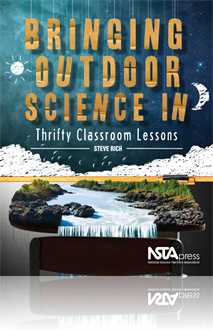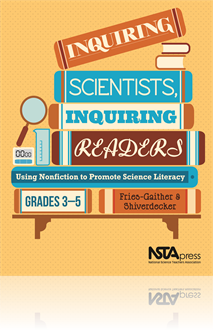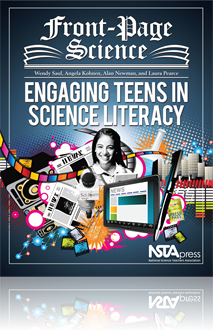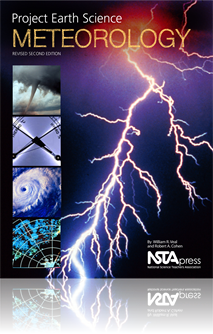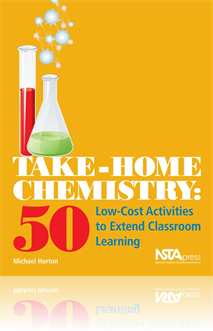All Book Chapters
Book Chapter
By having students discuss the ingredients that make up a healthy insect habitat and create a seed ball for habitat enhancement, students will be able to understand the components of a pollinator garden. ...
Book Chapter
In this activity, students will color and hide insects to learn about camouflage and use their sense of sight to search them out. By doing this, students will be able to demonstrate their knowledge of how camouflage and bright coloration is used for ...
Book Chapter
By having students will move through an outside area or school hallway to discover butterfly picture cards with messages that describe their migration challenges, students will be able to describe migration as a regular seasonal movement and identify...
Book Chapter
In this activity, students will be able to describe the mouth parts of insects and determine which is most effective for specific food types. ...
Book Chapter
Evolution:Nature’s Driving Force for Change
To be ecologically literate, students need to understand the process of natural selection. It is essential to an understanding of evolution. Groundwork for understanding natural selection can begin in the upper elementary grades. Local populations of...
Book Chapter
Early Memories and the Nature Connection
In this chapter the author reveals his early memories of nature. These events taught the author that connecting with nature entails not only admiration of its beauty and complexity, but also understanding and respect of its power. ...
Book Chapter
In the final chapter, the author concludes that now, more than ever before, we need a deepening concern for the well-being of others, not only those within the circle of our relatives and friends or the group to which we pledge allegiance, but to all...
Book Chapter
Goals of an Ecological Approach
Living systems are complex, thus tampering with them calls for great care. The “first, do no harm” principle should be paramount. Through chain reactions and unexpected interactions, widespread and sometimes catastrophic effects can occur. Fi...
Book Chapter
Developing Awareness and Exciting Interest
This chapter offers many examples of effective programs and approaches that can help restore and expand ecological connections—among them gardens planted and tended by the students, nature field trips, and other outdoor activities as learning tools...
Book Chapter
The High Cost of Ecological Illiteracy
In this chapter, the author considers three major educational impediments that must be remedied to get us to a harmonious relationship with nature. They are (1) isolation of ecology from mainstream education, (2) attitudes of domination or indiffere...
Book Chapter
Hopeful Prospects: A Historic Message That Almost Succeeded
The problems are interrelated and may seem insurmountable, but they can and must be resolved. Historic and recent efforts show the way to a positive outcome are explored in this chapter....
Book Chapter
Since the key to success of the nature-centered ecological program depends so heavily on direct personal experiences with living organ- isms and their habitats and on doing studies outdoors, it is important that ample time be allowed for the program,...
Book Chapter
Rocks and soil are indeed a part of everyday life and an important component of a complete science curriculum. Use the lessons in this chapter to introduce students to rocks and soils in their local area and beyond. The lessons in this chapter are Ex...
Book Chapter
The question students will answer through this chapter is, What can we discover by observing objects in the sky? Three separate but related investigations reveal patterns in the sky. The inquiry begins with an investigation into the changing shape of...
Book Chapter
Science Literacy: The Big Picture
In this opening chapter of Front-Page Science , the authors give an over view of science literacy and the layout of the book. ...
Book Chapter
Certainly a class can learn a lot by just engaging in activities described in the previous chapters in this book and not actually writing an article. The authors believe, however, that writing moves the student to a deeper level of understanding and ...
Book Chapter
It’s All About Revising: Moving Toward Publication
In this chapter, the authors present different ways to give students feedback on their writing, including conferences, peer feedback, and other assessment strategies....
Book Chapter
For reluctant writers or tech-savvy teens, engaging in alternative approaches to creating stories is an attractive approach. Creating podcast and videos can also provide opportunities for students to work in teams and learn the type of 21st-century s...
Book Chapter
Science Journalism Goes To School
What exactly is a science news article? To understand that, it is important to differentiate journalistic writing from other forms of expression. This chapter provides a detailed description of what the authors mean by a science news article and give...
Book Chapter
Can I Do This? Frequently Asked Questions
Teachers and administrators have expressed certain practical concerns, the answers to which help them decide if SciJourn is possible given the realities of their own school. In these Frequently Asked Questions (FAQs) the authors seek to address so...
Book Chapter
In this chapter, the authors briefly outline the process used to create the SciJourn standards, and then describe each in some detail, furnishing the reader with real student examples. As you seek to “sell” the project to your schools, parents, a...
Book Chapter
Literacy professionals often think about the connection between reading and writing. How does reading impact the ability to write and think? What do competent writers notice when they read? In this chapter, the authors suggest a systematic approach, ...
Book Chapter
Finding and Keeping Track of Sources
Scientifically literate people seek credible sources, knowing that they cannot always depend on firsthand encounters. Several credible sources are typically needed to assess the value of new findings or commercial product in order to confirm informat...
Book Chapter
In this chapter, the qualities of a good topic, how to “pitch” stories in the classroom (slow and fast), and a list of dos and don’ts for teachers when helping students refine topics and angles are discussed....
Book Chapter
Original Reporting: Interviews And Surveys
In this chapter, the authors discuss interviews and surveys from a science literacy standpoint; provides hints for how to conduct both and what to do with the results....
Book Chapter
Channeling Your Inner Science Teacher: Considering Context and Accuracy
This chapter includes ideas for helping students put information into context (Standard IV) and fact-checking their own and classmates’ articles (Standard V). Up to this point, as we discussed the creation of a news story, you as a science teacher ...
Book Chapter
Even though we cannot see it, water vapor is almost always present in the air, regardless of the temperature. This means that water vapor can exist at any temperature. What about liquid water? Can water exist as a liquid at any temperature? You will ...
Book Chapter
Separation Lab: Elements, Compounds, and Mixtures
In this activity, students will separate a mixture of sand, salt, Styrofoam (or Perlite), and iron....
Book Chapter
Probability of Finding an Electron
In this activity, students will use a target to simulate the probability of finding an electron in a certain energy level....
Book Chapter
In this activity, students will simulate the decay of radioactive isotopes by flipping papers and removing face-up papers....
Book Chapter
Rutherford’s Gold Foil Simulation
In this activity, students will simulate Rutherford’s gold foil simulation by rolling a marble (alpha particle) at a series of target marbles (gold atoms...
Book Chapter
In this activity, students will calculate the mean free path of a simulated gas sample....
Book Chapter
In this activity, students will see if the volume of an ice and water mixture goes up or down when the ice melts....
Book Chapter
In this activity, students will count how many drops of water they can put on the face of a penny with and without dishwashing liquid in the water....
Book Chapter
In this activity, students will estimate the density of cooking oil by comparing it to water...
Book Chapter
In this activity, students will perform paper chromatography on different inks to find the source of the ink....
Book Chapter
In this activity, students learn how to use a single-beam balance to determine the masses of objects. Students use the density of water to determine the mass needed to balance the objects....
Book Chapter
Mechanoluminescence: Making Things Light Up
In this activity, students will see how applying a force to a Wint-O-Green Life Saver causes it to light up....
Book Chapter
Intensive and Extensive Properties
In this activity, students will split colored water into different cups and observe the properties...
Book Chapter
In this activity, students will create a substance that does not clearly fall into the categories of solid, liquid, gas, or plasma....





